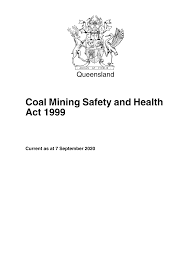
Mining Legislation -The Queensland Perspective Andrew Clough Department of Natural Resources and Mines, Queensland 2015
https://ro.uow.edu.au/cgi/viewcontent.cgi?article=2207&context=coal
Andrew Clough Mining Legislation -The Queensland Perspective
This paper was delivered at Wollongong University Coal Operators Conference 2015.
Mr Clough was Chief Inspector of Coal Mines until April 2015.
Below are excerpts
This paper present further detail on the legal framework and policies that support the safe operation of the mines in Queensland. Specific reference will be made to the CMSHA) and the underpinning regulations and policies although the material presented here is applicable to both Acts.
THE OBJECTIVES OF THE ACT AND HOW IT INTENDS TO ACHIEVE THESE
The objectives of this Act are:
- to protect the safety and health of persons at coal mines and persons who may be affected by coal mining operations;
- to require that the risk of injury or illness to any person resulting from coal mining operations be at an acceptable level; and
- to provide a way of monitoring the effectiveness and administration of provisions relating to safety and health under this Act and other mining legislation.
To ensure that risk is at an acceptable level, the legislation requires that management and operating systems must be put in place for each coal mine. The systems must incorporate risk management elements and practices appropriate for each coal mine to:
- Identify, analyse, and assess risk;
- Avoid or remove unacceptable risk;
- Monitor levels of risk and the adverse consequences of retained residual risk;
- Investigate and analyse the causes of serious accidents and high potential incidents with a view to preventing their recurrence;
- Review the effectiveness of risk control measures, and take appropriate corrective and preventive action; and
- Mitigate the potential adverse effects arising from residual risk.
This approach is in line with the Australian and New Zealand Standard AS/NZS 4360:1999 Risk Management.
CONSULTATION AND COOPERATION
The Act seeks to achieve cooperation between coal operators, mine management and coal workers to achieve the objects of the Act.
Cooperation is an important strategy in achieving the objects of the Act and is achieved at an industry level by:
- the establishment of the coal mining safety and health advisory committee
- the appointment of industry safety and health representatives
Cooperation is achieved at a coal mine level by:
- the election of site safety and health representatives; and
- the process of involving coal mine workers in the management of risk.
SAFETY AND HEALTH MANAGEMENT SYSTEMS
The CMSHA prescribes the requirements for the development of a safety and health management System. The CMSHR (Qld Govt, 2001) prescribe many of the components that must be included in the safety and health management system. The CMSHA has the force of legislation in that there is a requirement to comply with the procedures contained within.
It is the responsibility of the most senior officer employed by the operator who has responsibility for the mine Site Senior Executive (SSE) to develop the safety and health management system.
The safety and health management system must be:
- Be a documented and auditable system for implementing the organisations OHS policy
- Define the management structure necessary for safety and health
- Outline the processes and resources needed to manage the mine so that risk is at an acceptable level
- Deliver the strategy and plan to ensure that the mine is run safely
- Include principal hazard management plans and standard operating procedures;
- Contain a plan to regularly review and continually improve so that risk to persons at the coal mine is or an acceptable level; and
- When there is a significant change to the coal mining operations of the coal mine—contain a plan to immediately review the safety and health management system so that risk to persons is at an acceptable level.
The prescribed structure of the safety and health management plan must be consistent with the Australian and New Zealand Standard AS/NZS 4804:2001 Occupational health and safety management systems.
Principal hazard management plans are developed to manage hazards that could result in multiple fatalities. The regulations prescribe the minimum principal hazard management plans that must be developed for underground coal mines.
These are;
- emergency response;
- gas management;
- methane drainage;
- mine ventilation;
- spontaneous combustion;
- strata control; and
- inrush management
Each principal hazard management plan outlines the preventive controls required to lower the possibility of an incident occurring, the monitoring controls to ensure the preventive controls are effective, first response procedures to mitigate the effects of an incident if the preventive controls should fail and emergency procedures to recover from an incident.

